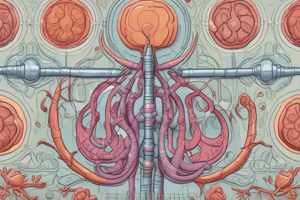Podcast
Questions and Answers
AKI is characterized by an increase in urine output.
AKI is characterized by an increase in urine output.
False (B)
The KDIGO criteria for AKI assessment were introduced in 2004.
The KDIGO criteria for AKI assessment were introduced in 2004.
False (B)
The RIFLE criteria for AKI assessment were introduced in 2007.
The RIFLE criteria for AKI assessment were introduced in 2007.
False (B)
AKI can be classified into only two types: pre-renal and intrinsic renal.
AKI can be classified into only two types: pre-renal and intrinsic renal.
AKI is characterized by a decrease in serum creatinine
AKI is characterized by a decrease in serum creatinine
The RIFLE criteria for AKI assessment were introduced in 2007
The RIFLE criteria for AKI assessment were introduced in 2007
AKI is classified into only pre-renal and intrinsic renal types
AKI is classified into only pre-renal and intrinsic renal types
The AKIN criteria for AKI assessment were introduced in 2012.
The AKIN criteria for AKI assessment were introduced in 2012.
The AKIN criteria for AKI assessment were introduced before the RIFLE criteria
The AKIN criteria for AKI assessment were introduced before the RIFLE criteria
AKI is characterized by an increase in glomerular filtration rate (GFR)
AKI is characterized by an increase in glomerular filtration rate (GFR)
The KDIGO criteria for AKI assessment were introduced in the same year as the AKIN criteria
The KDIGO criteria for AKI assessment were introduced in the same year as the AKIN criteria
Flashcards
AKI and Urine Output
AKI and Urine Output
AKI is characterized by a decrease in urine output, not an increase.
KDIGO Criteria Year
KDIGO Criteria Year
The KDIGO criteria for AKI assessment were not introduced in 2004.
RIFLE Criteria Date
RIFLE Criteria Date
The RIFLE criteria for AKI assessment were not introduced in 2007.
AKI Types?
AKI Types?
Signup and view all the flashcards
AKI and Creatinine
AKI and Creatinine
Signup and view all the flashcards
AKI and GFR
AKI and GFR
Signup and view all the flashcards
AKIN Criteria Year
AKIN Criteria Year
Signup and view all the flashcards
AKIN vs RIFLE Timeline
AKIN vs RIFLE Timeline
Signup and view all the flashcards
KDIGO and AKIN Year
KDIGO and AKIN Year
Signup and view all the flashcards




